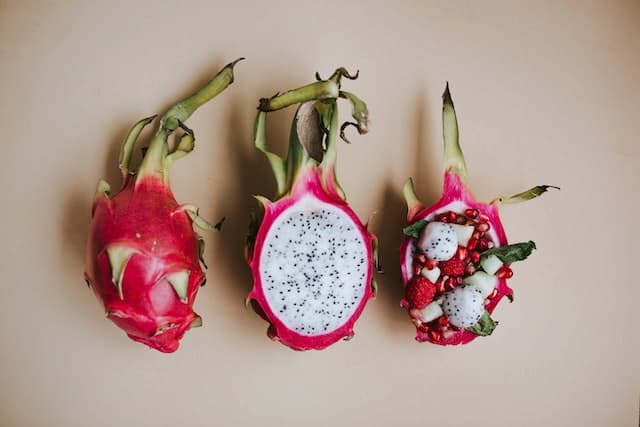Dragon fruit (or pitaya) is a tropical fruit that’s becoming increasingly popular in Kenya thanks to its numerous health benefits and a ready market. Dragon fruit plants usually begin flowering within eight months; each Pitaya fruit can weigh up to 500g, making dragon fruit farming in Kenya a lucrative venture.
Nutritional Benefits of Dragon Fruits
Dragon fruits are nutritious and are considered a superfood, packed with healthy nutrients, essential vitamins, and low calories. Here’s how you’ll benefit from eating these super fruits;
- Helps fight against chronic disease such as diabetes, cancer and arthritis.
- It contains lots of fiber which helps in digestion protecting you against heart disease and weight gain.
- Helps strengthen your immune system. Vitamin C in the dragon fruit may protect your white blood cells from damage.
- May help increase low iron levels.
- It contains prebiotics which help improve your gut.
Can Dragon Fruit Grow in Kenya?
Given the scanty rains experienced in Kenya, dragon fruit is ideal for cultivation since it thrives in semi-arid areas. The fruit grows well in Meru, Laikipia, Naivasha, Machakos, and Makueni.
Here are a few things you need to know about the commercial cultivation of dragon fruit.

Climate Requirements For Growing Dragon Fruit In Kenya
Dragon fruit plants can thrive in poor soil conditions as long as they are well-drained; they can also yield plenty of fruits despite temperature variations between 20-30 °C. The ideal annual rainfall is about 40-60mm. Where there’s too much direct sunlight, consider providing shading.
Soil Requirements
Dragon fruits can grow well in different soil types, from sandy-loam to clay-loam. Well-drained, sandy soils with good organic matter make the best growth substrate for dragon fruit farming. The ideal pH for growing pitaya is 5.5 to 7.
Propagating the Dragon Fruit Plant
The most popular fruit propagation method is cuttings, but you can also use seeds that take longer to grow. Dragon fruit seeds may also lack all the quality characteristics of the mother plant. During the propagation, you should use 20cm cuttings, ensuring that you pile up these cuttings at least two days before.
First, prepare pits spaced out two meters apart; these pits should measure 60 cm x 60 cm x 60 cm. And each should have a supporting concrete or wooden post for the climbing dragon plant vines.
While planting the cuttings, fill the pits with a topsoil and manure mix. Additionally, each plant needs inorganic fertilizers for good vegetative growth. The quantities for each plant cutting are 40g of muriate of potash, 90g of superphosphate, and 70g of urea.
During the fruit-bearing stage, you should adjust the proportions as follows: 100g of muriate of potash, 50g of superphosphate, and 50g of urea.
This solution increases your fruit yield, and you can apply it just before flowering, fruit development, or even after harvesting. An acre of farmland will easily accommodate about 1700 plants.
Dragon Fruit Irrigation and Pest Control
Since dragon fruit farming in Kenya requires less water during the planting, flowering, and fruit development stages, drip irrigation is highly effective. The plant is also resistant to pests and diseases.
Dragon Fruit Harvesting
Within the first year of propagation, your dragon fruit plants start bearing fruits between August-December. Fruits are usually ready for harvesting within a month of flowering. You can pick fruits up to six times within this flowering period.
The ideal time to harvest your dragon fruits is 3-4 days after they turn red. But for the export market, you should harvest them a day after they turn color. An acre yields five to six tons of dragon fruits.
Where to Get Dragon Fruit Seedlings in Kenya
You must source quality seedlings from a reliable seedling company for propagation. Seedlings cost about Ksh. 500 to Ksh. 800 each depending on the vendor.
You can buy dragon fruit seedlings from Rich Farm Kenya, Lavington Herbs, Mkulima Young, Oxfarm, Batian Nuts Limited, and the online marketplace Jiji.
You can also buy seedlings from independent dragon fruit farmers in Meru, Naivasha, Laikipia, Machakos, or Makueni.
Additionally, if you know a seedling vendor that sells them by the roadside, you could ask them if they also have dragon fruit seedlings. In most cases, you’ll get, or they will refer you to a reliable source.
Where to Sell Dragon Fruit in Kenya
There’s increasing demand for dragon fruits, but the supply remains low. Upmarket areas with a ready market for the fruit include Muthaiga, Westlands, Karen, and Parklands; here, they are popular among the Asian communities.
Supermarkets, hotels, and open-air markets are also great places for selling your fruits after harvesting, as more Kenyans appreciate the numerous health benefits of the dragon fruit.
Lastly, the export market remains largely untapped, as dragon fruit farming is relatively new in Kenya. A kilo of dragon fruits retails between Ksh. 1,000 to Ksh. 2,000.
How To Eat A Dragon Fruit
Slice the fruit lengthwise, scoop out the pulp with a spoon, or cut it into cubes and mix it into your favorite salads, yogurt, or smoothies. You can also snack on the fruit by itself, as it has a delicious flavor, a slightly sweet cross between a pear and a kiwi fruit.
Conclusion
Dragon fruit farming in Kenya is one of the most lucrative farming ventures, thanks to its low production cost, high yield, and ready local and international market that remains untapped.


